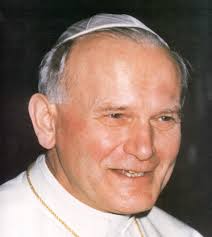John Paul II’s papacy is noted for many things, yet two stand out for me as significant in his legacy to the Church.  Today as the liturgical date for canonization of our two recent popes is not without meaning – even irony – for one of these.
Today as the liturgical date for canonization of our two recent popes is not without meaning – even irony – for one of these.
First of all, who is John Paul? Saint John Paul was born Karol Jozef (Charles Joseph, in English) Wojtyla of Polish nationality in 1920. As an adolescent in Nazi-overrun Poland during World War II, Wojtyla lost close friends and got an up-close view of authoritarian and totalitarian government. As the only pope to serve from Polish ethnicity, John Paul was uniquely qualified in the role he took on in the first decade of his papacy to affirm the dignity of man and thereby assist in bringing on the demise of the atheist Soviet Union.
His Mercy Endures Forever…
Today is Divine Mercy Sunday, proclaimed by John Paul in the Jubilee Year of 2000 to be permanently celebrated on the Second Sunday of Easter; Psalm 118 is the Scriptural celebration of God’s Divine Mercy. John Paul’s proclamation was at the canonization of St. Faustina Kowalska, the Apostle of Divine Mercy’, a 20th century Polish nun who received visions of Jesus and Divine Mercy. While John Paul was an ambassador or role model for divine mercy, no image would be more powerful that that of Saint John Paul meeting with his would-be assassin to forgive him. John Paul attributed his survival of the shooting to the intercession of the Blessed Mother.
Theology of the Body
Saint John Paul’s contribution to theology- the study of our relationship with God- comes from a series of 129 lectures given between 1979 and 1984. His Scripturally-based discourses focused on what it means to be human, created in the imago Dei, image and likeness of God. Anthropologically speaking, John Paul presented an integrated understanding of a human person – body, spirit, and soul. His vision means that if we truly see others, we can see God in each other; we can know God by truly seeing who one another is.
On a related note, Lectio Publishing has just released a new book whose author extends the concept of Theology of the Body – as John Paul himself suggested should be done – to explore the human stages of childbirth, impairment, and dying as spiritual signs pointing to our own human imago Dei. Discover more about this interesting and readable book on the Lectio website, and download an ePub excerpt.
Did You Know?
In the last blog I talked about Saint John XXIII as having rocked the Catholic world by convening Vatican Council II and the following pope- Paul VI as continuing the Council for three more sessions/years. When Pope Paul VI died in 1978, Cardinal Luciani was elected pope and took the names of his two predecessors signifying that he would continue in the ideas and work of the Second Vatican Council. This Pope John Paul I would be the last in a centuries-long line of Italian popes (at least until this writing!). We do not hear anything about John Paul I because he died a month after becoming pope. Cardinal Wojtyla was then elected pope, taking the name of John Paul II again continuing the tradition of Vatican II. John Paul I was one of the shortest papacies in history; John Paul II was the third-longest serving pope in history.
Interesting tidbit: according to John Allen, a reporter assigned to the Vatican, of the 268 popes in Catholic history, only 80 have been canonized, and prior to today, only seven had been canonized in the last 1,000 years!
And in memory of Saint John Paul, I give you his Scriptural mantra: Peace be with you!
— Eric Wolf
 Pope Saint John XXIII, born Angelo Roncalli in 1881, was ordained a priest in 1904 and was active as both a papal diplomat and a diocesan bishop. Elected pope by the College of Cardinals in 1958, one of his first acts was to buck the hierarchy and call for an Ecumenical Council- the first in nearly a century. The theme of this blog site is ‘aggiornamento for 21st century America”; Saint John XXIII popularized the Italian term, which means a ‘bringing up to date’, in his description of the reason for Vatican Council II: it was time to fling open the windows and allow in fresh air. The holy pope presided over the first session of the historic Council in Autumn 1962 and then died in June 1963. The remaining three sessions of the Vatican Council continued under the auspices of Pope Paul VI in the autumns of 1963-65.
Pope Saint John XXIII, born Angelo Roncalli in 1881, was ordained a priest in 1904 and was active as both a papal diplomat and a diocesan bishop. Elected pope by the College of Cardinals in 1958, one of his first acts was to buck the hierarchy and call for an Ecumenical Council- the first in nearly a century. The theme of this blog site is ‘aggiornamento for 21st century America”; Saint John XXIII popularized the Italian term, which means a ‘bringing up to date’, in his description of the reason for Vatican Council II: it was time to fling open the windows and allow in fresh air. The holy pope presided over the first session of the historic Council in Autumn 1962 and then died in June 1963. The remaining three sessions of the Vatican Council continued under the auspices of Pope Paul VI in the autumns of 1963-65.